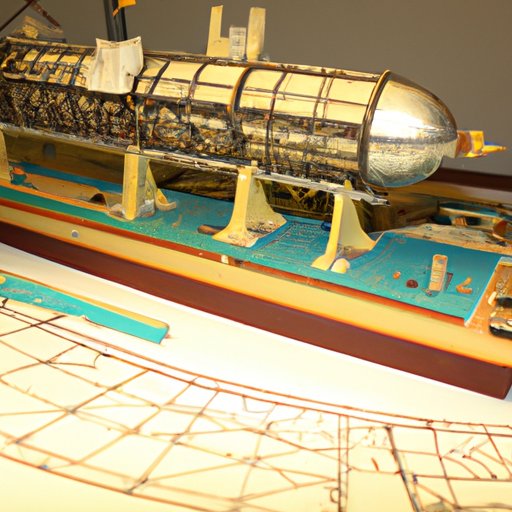An Overview of Scale Models in Science
Scale models are representations of physical objects or systems that have been reduced in size. They can be used to study the behavior of a system, to represent something that is too large or too small to observe directly, or to test out theories and hypotheses. Scale models are particularly useful in the fields of science, engineering, and architecture.
The term “scale” refers to the ratio between the size of the model and the size of the object or system it represents. For example, if a model is 1/10th the size of the original object, then the scale would be 1:10. Scale models may be constructed using three-dimensional objects, two-dimensional drawings, or even mathematical equations.
Examples of scale models used in science include models of planets, rockets, bridges, buildings, and other structures. Scale models are also used to simulate experiments, such as the movement of fluids through pipes or the interactions of particles in a gas.
Exploring the Benefits of Building Scale Models
Scale models offer a number of advantages over direct observation and experimentation. For one, they provide a cost effective way to study a system or object without having to build a full-sized version. They also allow for more accurate simulations than could be achieved with real-world experiments.
Building scale models also gives scientists the ability to observe and analyze data in a controlled environment. This means they can focus on specific elements of a system while eliminating any potential confounding variables. Additionally, scale models can be used to accurately replicate natural phenomena, such as the motion of waves or the flow of air around an aircraft.
Finally, scale models offer a way to explore questions or make predictions about a system without having to build the actual system itself. This can save time and money while still providing valuable insights into the behavior of a system or object.

The Role of Scale Models in Scientific Research
Scale models play an important role in scientific research. They can help scientists better understand complex systems, develop new technologies, and test hypotheses. By creating a scaled-down version of a system or object, scientists can observe and analyze the behavior of the system without having to build the entire system.
Scale models can also be used to simulate experiments and analyze the results. This can help scientists make predictions about the behavior of a system without having to conduct actual experiments. Furthermore, scale models can be used to create prototypes of new technologies, allowing scientists to test out their ideas before committing resources to building a full-scale version.

How Scale Models Help Scientists Understand Complex Systems
Scale models can help scientists visualize data and investigate cause and effect relationships. By constructing a model of a system, scientists can observe how different components interact with each other and how changes to one component affect the entire system. This can help them identify patterns and draw conclusions about the behavior of the system.
Scale models can also be used to analyze dynamic systems. By constructing a model of a changing system, scientists can observe how the system evolves over time and make predictions about the future behavior of the system. This can be invaluable for understanding complex systems such as climate change or economic cycles.
The Different Types of Scale Models Used in Science
There are three main types of scale models used in science: physical models, mathematical models, and computer models. Physical models are constructed using physical materials such as wood, metal, and plastic. Mathematical models are created using equations and algorithms. Computer models are created using computer software and hardware.
Physical models are often used to represent simple systems or objects, such as bridges or buildings. Mathematical models are used to represent more complex systems, such as the motion of fluids or the interactions of particles in a gas. Computer models are used to simulate complex systems, such as weather systems or the economics of a country.

A Look at Famous Scale Model Projects in Science
Scale models have been used in some of the most famous scientific projects in history. The Apollo Space Program used scale models to test the design of the spacecraft and the landing gear. The Large Hadron Collider used scale models to study the behavior of particles at high energies. And the Voyager mission used scale models to simulate the journey of the spacecraft.
These models allowed scientists to test out theories and hypotheses without having to build the actual systems or objects. This saved time and money while still providing valuable insights into the behavior of the systems.

Examining the Use of Scale Models in Education
Scale models can also be used in the classroom to enhance student engagement and facilitate learning and understanding. By constructing a scale model of a system or object, students can gain a better understanding of how it works and how different components interact with each other.
Scale models also allow for experimentation and exploration. By manipulating the model, students can observe how changes to one component affect the entire system. This can be invaluable for developing problem-solving skills and fostering creative thinking.
In addition, scale models can be used to create simulations of real-world phenomena. This can help students better understand complex concepts and gain a deeper appreciation for the world around them.
Conclusion
Scale models are powerful tools for studying systems and objects in science, engineering, and architecture. They provide a cost effective way to observe and analyze data, create accurate simulations, and understand complex systems. Scale models can also be used to develop new technologies, test hypotheses, and enhance student engagement and learning.
(Note: Is this article not meeting your expectations? Do you have knowledge or insights to share? Unlock new opportunities and expand your reach by joining our authors team. Click Registration to join us and share your expertise with our readers.)
